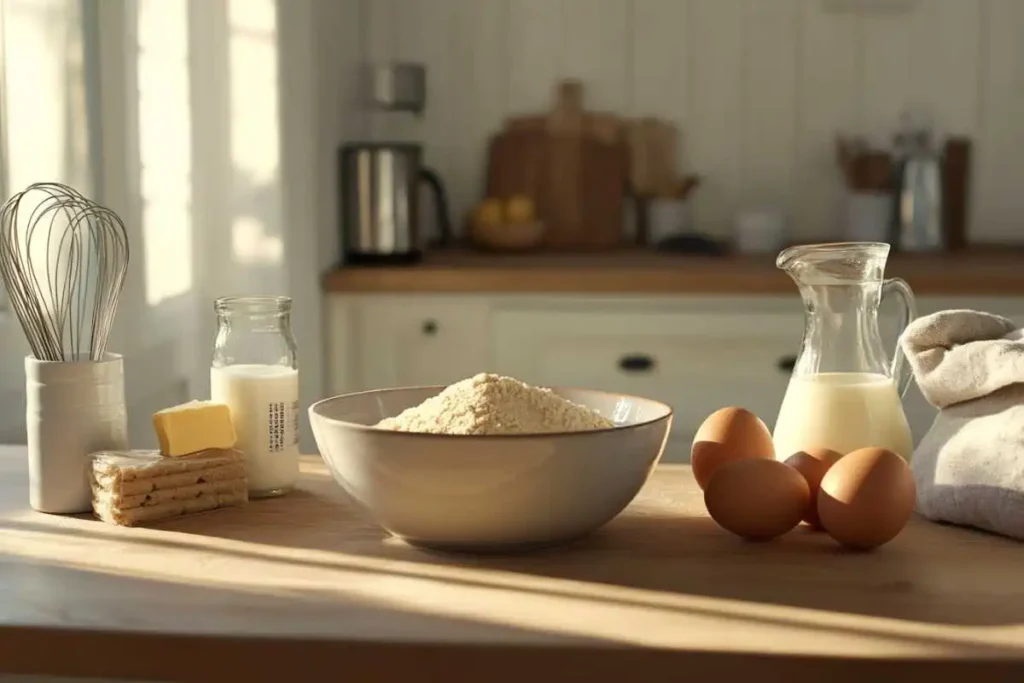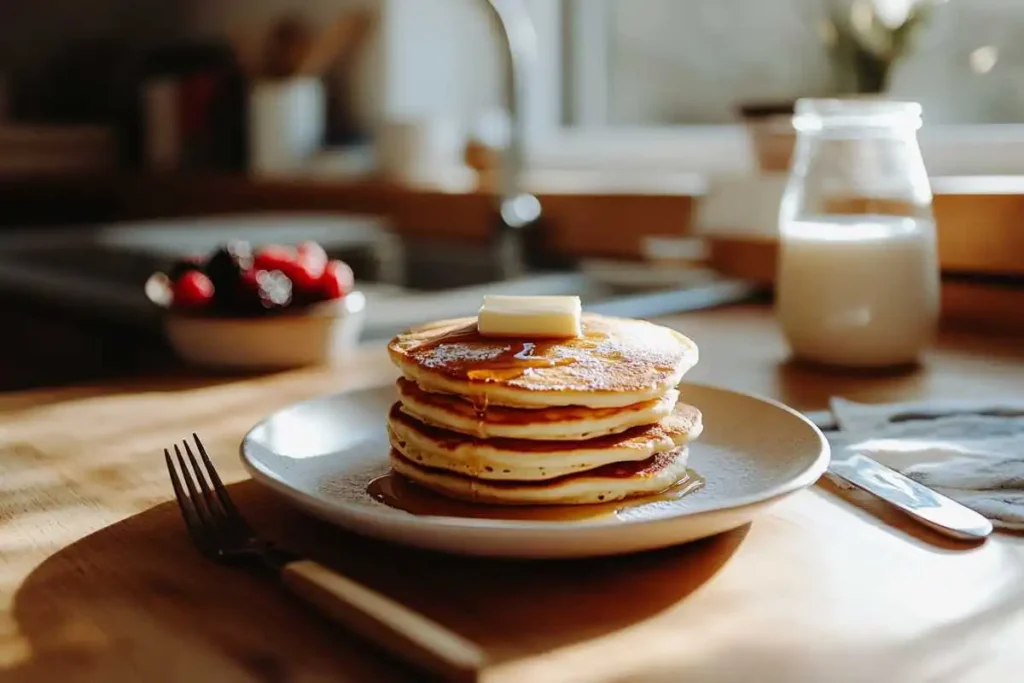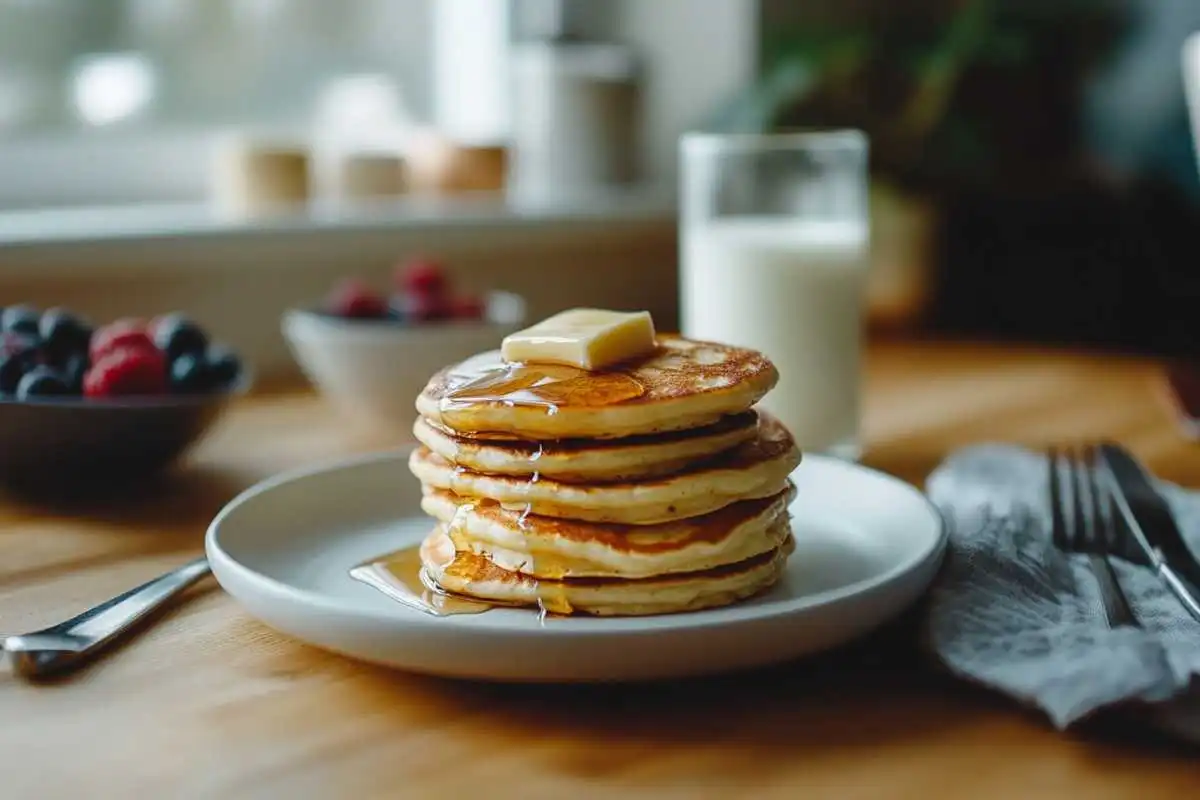Pancakes are a beloved breakfast staple, cherished for their fluffy texture and endless topping possibilities. However, the secret to achieving perfect pancakes lies in one critical step: mastering how to mix the pancake mix. From balancing the right ingredients to using proper techniques, every detail contributes to the texture, flavor, and overall success of your pancakes.
In this guide, we’ll explore the essentials of mixing pancake batter, highlight common mistakes to avoid, and share tips for customization to suit any preference. Whether you’re a seasoned cook or a pancake enthusiast, this step-by-step approach will help you create delicious pancakes every time. Let’s dive into the art of mixing and take your breakfast game to the next level!
The Basics of How to Mix the Pancake Mix?
Mixing pancake batter may seem simple, but achieving the perfect texture requires attention to detail. From understanding the ingredients to using the right techniques, learning how to mix the pancake mix can transform your breakfast routine.
Ingredients: The Foundation of Pancakes
Before diving into the mixing process, it’s essential to familiarize yourself with the key components of pancake mix. Most mixes include:
- Flour: Provides structure and the foundation of the batter.
- Sugar: Adds sweetness to the pancakes.
- Leavening Agents: Baking powder or baking soda creates the fluffiness.
- Salt: Enhances the overall flavor.
For a richer flavor, many people use milk or buttermilk instead of water. To explore how ingredient choices affect texture, try making a batch with our hotcake mix recipe for a denser, sweeter result.
Liquids: Water, Milk, or Buttermilk?
The type of liquid you use will determine the pancake’s texture and taste:
- Water: Produces a lighter, more neutral flavor.
- Milk: Adds creaminess and richness to the batter.
- Buttermilk: Enhances the tanginess and reacts with leavening agents for extra fluffiness.
If you’re deciding between liquid options, consider how milk elevates flavor in other dishes, such as our difference between hotcake and pancake guide.
Step 1: Measuring the Ingredients
Accurate measurements are crucial to achieving a balanced batter. Here’s a standard recipe for most pancake mixes:
| Ingredient | Quantity |
|---|---|
| Pancake Mix | 1 cup |
| Liquid (water, milk, or buttermilk) | ¾ cup |
| Egg (if required by the mix) | 1 |
| Melted Butter or Oil | 2 tablespoons |
For unique flavor variations, consider incorporating a pinch of cinnamon or a teaspoon of vanilla extract, similar to how toppings and spices elevate recipes like roasted apricots salad.
Step 2: Combining Dry and Wet Ingredients
Mixing Dry Ingredients
- In a medium-sized bowl, whisk the pancake mix to distribute the leavening agents evenly.
Mixing Wet Ingredients
- In a separate bowl, whisk together your liquid, egg, and melted butter or oil until smooth.
Creating the Batter
- Make a well in the center of the dry ingredients and pour the wet ingredients into the middle.
- Gently stir the mixture until just combined. A few small lumps are fine; they help prevent overmixing, which can make the pancakes tough.
If you’re new to this process, compare these techniques to how ingredient balance affects other recipes like our chimichurri tomato pizza for insights into combining components effectively.
Step 3: Achieving the Right Batter Consistency
The batter should be thick yet pourable. If it’s too thick, add a splash of liquid until it reaches the desired consistency. Conversely, if the batter is too thin, incorporate a little more pancake mix.
Tips for Success
- Rest the Batter: Letting the batter sit for 5–10 minutes allows the flour to hydrate and the gluten to relax, resulting in more tender pancakes.
- Don’t Overmix: Stirring too much develops gluten, leading to dense pancakes.
- Adjust for Add-Ins: If you’re adding blueberries, chocolate chips, or nuts, fold them in gently at the end to avoid breaking them.
For additional insights on balancing ingredients, refer to our garlic parmesan chicken pasta recipe, which demonstrates how thoughtful preparation can elevate simple dishes.
Why Mixing Matters
Properly mixing pancake batter ensures:
- A uniform texture throughout the pancake.
- Even cooking on the griddle or skillet.
- A fluffy and light pancake that’s neither too dense nor too dry.
Understanding how to mix the pancake mix is the first step toward mastering this breakfast staple. With the right techniques and a touch of creativity, you can make every batch better than the last.
Advanced Techniques for How to Mix the Pancake Mix?

Mastering how to mix the pancake mix goes beyond combining ingredients. It requires attention to detail in preparation, understanding when and how to tweak the batter, and knowing the secrets to elevate your pancakes to the next level. This section delves into advanced tips, common mistakes to avoid, and how to adapt your mix for different occasions.
Customizing Your Pancake Mix for Texture and Flavor
The versatility of pancake mix allows for endless customization. Small adjustments can lead to significant changes in texture, flavor, and appearance.
Adjusting for Fluffier Pancakes
- Add Buttermilk: The acidity of buttermilk reacts with leavening agents, creating extra lift and fluffiness. This is especially useful if you enjoy pancakes with a tangy undertone, similar to those described in our difference between hotcake and pancake article.
- Separate and Whip Egg Whites: For an ultra-fluffy texture, separate the egg whites and whip them until stiff peaks form. Fold them gently into the batter at the end.
Enhancing Flavor
- Incorporate Vanilla or Almond Extract: Just a teaspoon of these extracts can add a subtle depth of flavor.
- Spices and Zests: Add cinnamon, nutmeg, or citrus zest for a unique twist.
If you’re exploring additional ways to infuse flavor into a dish, check out how creative spices are used in our chimichurri tomato pizza recipe.
Adapting the Pancake Mix for Dietary Preferences
Understanding how to mix the pancake mix for dietary needs ensures everyone can enjoy this breakfast classic.
Gluten-Free Pancakes
- Use a gluten-free pancake mix or substitute all-purpose flour with a gluten-free blend.
- Add an extra egg or a teaspoon of xanthan gum for improved structure and binding.
Vegan Pancakes
- Replace eggs with flaxseed or chia seed mixtures (1 tablespoon of seeds + 2.5 tablespoons of water per egg).
- Use plant-based milk like almond, oat, or soy milk.
For more ideas on adapting recipes, see how thoughtful ingredient substitutions can enhance dishes like garlic parmesan chicken pasta.
Resting and Testing the Batter
Why Resting is Important
Resting your pancake batter for 5–10 minutes allows the flour to fully hydrate and the gluten to relax. This step leads to a smoother texture and more tender pancakes.
Testing Consistency
- The batter should flow easily off a spoon but hold its shape. Adjust as needed:
- Too thick? Add a tablespoon of milk or water at a time.
- Too thin? Sprinkle in a little more pancake mix and gently stir.
Common Mistakes When Mixing Pancake Batter
Avoiding these pitfalls will ensure your pancakes turn out perfectly every time.
Overmixing the Batter
Stirring too much can develop gluten, making pancakes dense and chewy. Mix until the wet and dry ingredients are just combined, leaving small lumps in the batter.
Skipping the Resting Period
Without resting, the pancakes may cook unevenly or have a gritty texture.
Using the Wrong Liquid
Choosing the wrong liquid can drastically alter the final texture and flavor. For richer pancakes, always opt for milk or buttermilk over water, as described in the hotcake mix recipe.
Cooking Techniques That Depend on Proper Mixing
Even with a perfectly mixed batter, the cooking method can make or break your pancakes.
Preheating the Pan
- Use a non-stick skillet or griddle and heat it over medium-low. A drop of water should sizzle but not evaporate instantly.
Pouring the Batter
- Use a ladle or measuring cup to pour consistent amounts of batter onto the pan. This ensures even-sized pancakes.
Flipping with Care
- Wait for bubbles to form on the surface and the edges to set before flipping. Cook the second side until golden brown.
For more guidance on balancing ingredients and cooking methods, check out our roasted apricots salad recipes.
Using Pancake Mix Beyond Breakfast
Learning how to mix the pancake mix opens up opportunities to use it creatively in other recipes.
Waffles
Add an extra egg and reduce the liquid slightly for a thicker batter suitable for waffles.
Savory Creations
Use less sugar and add savory ingredients like herbs, cheese, or chopped vegetables to create unique pancake appetizers.
Desserts
Transform pancake mix into sweet treats like funnel cakes or crêpes by adjusting the batter consistency and adding sugar or cocoa powder.
FAQs About How to Mix the Pancake Mix?
Do I Add Water or Milk to Pancake Mix?
Milk or buttermilk is preferred for richer, creamier pancakes, while water creates a lighter texture.
Do I Add Egg to Pancake Mix?
Many mixes require eggs to add structure and moisture. Always check the package instructions.
What is the Ratio of Water to Pancake Mix?
A typical ratio is 1:1 (1 cup of mix to 1 cup of liquid), but refer to the mix instructions for accuracy.
How to Make a Pancake in 4 Steps?
1- Mix the batter gently until just combined.
2- Preheat and grease the pan.
3- Pour the batter and cook until bubbles form.
4- Flip and cook the other side until golden brown.
Can Pancake Batter Be Stored Overnight?
Yes, but it’s best to refrigerate it in an airtight container. Stir gently before cooking to redistribute ingredients.
How Do I Keep Pancakes Warm While Cooking in Batches?
Place cooked pancakes on a baking sheet in a 200°F (93°C) oven to keep them warm until serving.
Can I Freeze Pancake Batter Instead of Cooked Pancakes?
Freezing batter is not recommended as the leavening agents may lose their effectiveness, affecting fluffiness.
Perfecting How to Mix the Pancake Mix?
By understanding the nuances of mixing, customizing, and cooking pancake batter, you can consistently create delicious pancakes tailored to your preferences. Whether you’re experimenting with flavors or adapting for dietary needs, mastering these techniques will elevate your breakfast game. For further inspiration, explore creative options like the difference between hotcake and pancake to expand your pancake repertoire.
Serving and Storing Pancakes After Learning How to Mix the Pancake Mix?

Once you’ve mastered how to mix the pancake mix, it’s time to focus on serving and storing your pancakes to ensure they remain delicious. This section will guide you on plating, pairing, storing leftovers, and reheating for consistent quality.
Serving Pancakes: Ideas for Any Occasion
Understanding how to mix the pancake mix ensures your pancakes are the perfect base for any topping or side. Here’s how to elevate them for various meals and occasions.
Sweet Toppings
- Classic Options: Drizzle maple syrup or honey over your stack and top with a pat of butter for the quintessential pancake experience.
- Fruity Variations: Add fresh berries, bananas, or a dollop of fruit compote to bring natural sweetness and vibrant color.
To explore how fruits enhance any dish, refer to our roasted apricots salad recipes, which pair perfectly with pancakes.
Savory Pairings
- Protein Boost: Serve with crispy bacon, sausage, or scrambled eggs for a hearty breakfast.
- Savory Creations: Use less sugar in the batter and pair with toppings like smoked salmon, cream cheese, or sautéed mushrooms.
For more ideas on balancing flavors, check out our chimichurri tomato pizza recipe, which offers insights into pairing savory and tangy components.
Storing Leftover Pancakes
When you’ve perfected how to mix the pancake mix, it’s natural to want to save your extras. Proper storage ensures they remain fresh for later enjoyment.
Refrigerating Pancakes
- Short-Term Storage: Place cooled pancakes in an airtight container and refrigerate for up to 3 days.
- Layer Separation: Use parchment paper between pancakes to prevent sticking.
Freezing Pancakes
- For Long-Term Storage: Lay pancakes flat on a baking sheet lined with parchment paper. Freeze for 1–2 hours, then transfer them to a freezer-safe bag.
- Label and Date: Mark the bag to track storage time.
For additional storage tips, consider methods used for dishes like garlic parmesan chicken pasta, which emphasize maintaining freshness and texture.
Reheating Pancakes Without Losing Texture
Reheating pancakes properly is just as important as learning how to mix the pancake mix. The goal is to retain their fluffy texture while warming them evenly.
In the Microwave
- Place pancakes on a microwave-safe plate and cover with a damp paper towel.
- Heat in 15–20 second intervals until warmed through.
On the Stovetop
- Heat a non-stick pan over medium heat.
- Add a small pat of butter to the pan and warm pancakes for about 30 seconds on each side.
In the Oven
- Preheat your oven to 350°F (175°C).
- Place pancakes on a baking sheet in a single layer, cover with aluminum foil, and bake for 5–10 minutes.
For more tips on reheating while maintaining quality, explore our hotcake mix recipe, which provides insights into retaining the best textures.
Creative Uses for Leftover Pancakes
If you’ve made too many pancakes, repurpose them into new and exciting dishes.
Pancake Sandwiches
- Use pancakes as bread and fill with peanut butter, jam, or Nutella for a quick snack.
- For savory options, layer pancakes with scrambled eggs, bacon, and cheese.
Pancake Cake
- Stack pancakes with layers of whipped cream, berries, and syrup for a dessert-like treat.
For more inspiration on using leftovers creatively, see how balance and layering enhance recipes like our difference between hotcake and pancake.
Conclusion: From Mixing to Serving Perfect Pancakes
Mastering how to mix the pancake mix is just the beginning of creating perfect pancakes. By focusing on serving, storing, and reheating, you can extend their deliciousness far beyond breakfast. Whether you’re pairing them with sweet toppings, repurposing leftovers, or storing extras for later, every step contributes to a satisfying pancake experience.
For more ideas on elevating breakfast, explore our chimichurri tomato pizza recipe and hotcake mix recipe to inspire your next culinary adventure.

